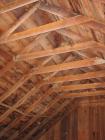78
A interior closeup of the A-frame construction of the roof12 March 2008
Mill Creek, Kelowna, Okanagan Valley, British Columbia
 Credits:
Credits:Samantha Poling
79
Page 25Interview with Reverend Everett Fleming, May 1979
"How did he set up the mill and get it running?"
"I'm often asked that question when people look at the mill and look at the creek (Mill) flowing a few feet lower down and a couple of hundred feet in front of the building. How in the world did he get any power from the creek to run the mill? Brent had to go back up to the weir (dam) in the creek and dig it to a variety of depths from one to two feet. He either had surveyors' equipment or a very keen eye. He brought the ditch down to within three hundred feet of the house and divided it in two. One branch went south, to irrigate what was the biggest
Page 26
hay field in the valley. The other branch came between the house and the mill where he built a flume. The flume was about three feet wide and ten or twelve inches deep. It was supported on round poles. The flume then ran to the top of a small overshot hand-made water wheel."
"What was the size of the wheel?"
"The wheel was moderately small, not more than six feet in diameter on the outside, including the casing and cups. There was a core in the middle that was about a foot in diameter, that had a wide belt through the middle of it. Then there were the cups and the facing. The cups were hand-made and resembled small water troughs. They were set facing the flume, where water gushed into them. When one filled up and fell down, the next one came up. In this way the wheel was turned. The large belt that was connected to the handrail was also turned. The belt, about eight inches wide, was geared back to a series of pulleys inside and one major pulley outside. These pulleys operated the mill itself. They also operated a conveyor belt that took the ground meal up to the second floor where it was sifted and put through the bolting bin. This bolting bin needed another series of belts to rotate the agitators that were inside the silk casing. The bolting bin was two feet by eight feet. . . . . . "
"What was used for the screening?"
"The screening material was a heavy type of white silk and it lined a wooden cabinet. The wood on this bolting bin is polished, probably the result of abrasion from the action of bolting."
*[In "Ogopogo's Vigil" by F.M. Buckland, 1948, p. 46, it was stated, "The first bolter or separator, was, like the water wheel which drove the mill, homemade, and turned out three grades - flour, shorts and bran. Later a bolter manufactured in Brantford, Ontario was brought in. It was of hard wood but unfortunately it has been demolished."]